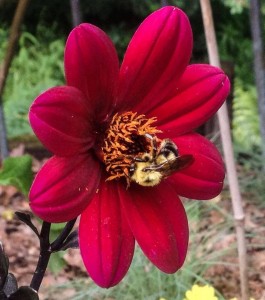I recently learned of an exciting new program called the Million Pollinator Garden Challenge. Since I love watching all the bees, butterflies, dragonflies and hummingbirds that come to both my home garden and the “Better Late Than Never Garden” across the street from the shop, it was great to hear of a national program designed to help preserve them.
 The National Pollinator Garden Network, encourages home gardeners, cities, community and public spaces to plant for our all-important pollinators.
The National Pollinator Garden Network, encourages home gardeners, cities, community and public spaces to plant for our all-important pollinators.
So, in your own gardens, plant flowering nectar plants with your vegetables, add herbs like curly parsley, dill and fennel for caterpillars, basil, rosemary, mint, and lavender for bees, and stay away or at least please minimize the use of pesticides that kill beneficial insects as well as bad bugs.
I’ve learned I’d rather live with a few holes in leaves and a less than perfect garden than not have as many bees, butterflies, and hummers that add so much enjoyment to my personal space.
The National Wildlife Federation, national garden clubs and other organizations are joining in this effort to create a million (or more!) pollinator gardens across the country. I’m planning to register my garden and the “Better Late Than Never Garden” and hope you’ll join in too!
Pollinator Plants For Bees, Butterflies, and More
Perennials include: Anise hyssop (Agastache), Aster, Butterfly Milkweed (Asclepias sp.), Baptisia, Coreopsis, Daylily (Hemerocallis), Dianthus, Black-eyed Susan (Rudbeckia sp.), Bee balm (Monarda), Joe Pye weed (Eutrochium), Blazing star (Liatris), Gaura, Lavender, Mint, Thyme, Oregano, Phlox, Daisies, Yarrow (Achillea), Sunflower, (Helianthus sp.), Goldenrod (Solidago), Coneflower (Echinacea sp.), Verbena
Annuals include: Zinnia, Sunflower, Purslane, Mexican Heather (Cuphea sp.) Mecardonia, Salvia, Cosmos, Alyssum, Basil, Nasturtium, Verbena, Lantana, Fan Flower (Scaevola), Gomphrena
For Hummingbirds: Ajuga, Bee Balm, (Monarda sp.), Begonia, Spider Flower (Cleome), Salvia, Cardinal Flower (Lobelia), Lilies, Penstemon
These lists are by no means exhaustive, and don’t include shrubs and trees that are host plants for caterpillars as well. Don’t hesitate to do research into pollinator gardens as you create your own!
Posted by Kris Blevons




